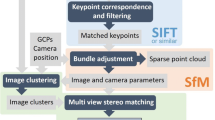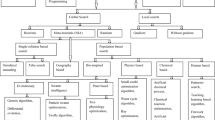Abstract
Heuristic methods are commonly used in complicated spatial forest planning problems to find the best combination of management alternatives for stands. The performance of heuristic methods depends on the parameters that guide their search processes. This study used numerical optimization to find the optimal parameter values for simulated annealing (SA), threshold accepting (TA), great deluge (GD), tabu search (TS), genetic algorithm (GA) and ant colony optimization (AC) when they are used for combinatorial optimization in forest planning. Ant colony optimization was implemented using the Max–Min Ant System, which was applied for the first time to forest planning problem. Solutions found by different heuristic methods for a non-spatial and a spatial forest planning problem were compared in a situation where the search time was restricted. The comparisons revealed that SA and TA were the best methods for fast search in both non-spatial and spatial problems. GA and AC were the least satisfactory methods, and GD and TS were between the best and the worst heuristics. The main reason for the poor performance of GA and AC was their slow search process. Differences between heuristic methods decreased when the allowed search time increased.






Similar content being viewed by others
References
Baskent EZ, Keles S (2005) Spatial forest planning: a review. Ecol Model 188:145–173
Bettinger P, Graetz D, Boston K, Sessions J, Chung W (2002) Eight heuristic planning techniques applied to three increasingly difficult wildlife planning problems. Silva Fennica 36:561–584
Bettinger P, Boston K, Siry JP, Grebner DL (2009) Forest management and planning. Academic Press Elsevier, Amsterdam (ISBN 978-0-12-374304-6)
Blum C (2005) Ant colony optimization: introduction and recent trends. Physics of Life Reviews 2:353–373
Borges JG, Hoganson HM, Falcão AO (2002) Heuristics in multi-objective forest management. In: Pukkala T (ed) Multi-objective forest planning. Kluwer Academic Publisher, Dordrecht (ISBN 1-4020-1097-4)
Boston K, Bettinger P (1999) An analysis of Monte Carlo Integer programming, simulated annealing, and tabu search heuristics for solving spatial harvest scheduling problems. Forest Science 45:292–301
Boston K, Bettinger P (2002) Combining tabu search and genetic algorithm heuristic techniques to solve spatial harvest scheduling problems. Forest Science 48:35–46
Constantino M, Martins I, Borges JG (2008) A new mixed integer programming model for harvest scheduling subject to maximum area restrictions. Oper Res 56:542–551
Dorigo M, Birattari M, Stützle T (2006) Ant colony optimization. Artificial ants as a computational intelligence technique. IEEE Computational Intelligence Magazine, November 2006: 28-39
Eyvidson K, Kangas A (2014) Stochastic goal programming in forest planning. Can J For Res 44(10):1274–1280
Falcão AO, Borges JG (2002) Combining random and systematic search heuristic procedures for solving spatially constrained forest management scheduling problems. Forest Science 48:608–621
Haight RG, Brodie JD, Adams DM (1985) Optimizing the sequence of diameter distributions and selection harvests for uneven-aged stand management. Forest Science 31(2):451–462
Heinonen T, Pukkala T (2007) The use of cellular automaton approach in forest planning. Can J For Res 37:2188–2200
Hoganson HM, Rose DW (1984) A simulation approach for optimal timber management scheduling. Forest Science 30:220–238
Hooke R, Jeeves TA (1961) “Direct search” solution of numerical and statistical problems. Journal of the Association for Computing Machinery 8:212–229
Islam NMd, Kurttila M, Mehtätalo L, Pukkala T (2010) Inoptimality losses in forest management decisions caused by errors in an inventory based on airborne laser scanning and aerial photographs. Can J For Res 40:2427–2438
Jin X, Pukkala T, Li F (2016) A management planning system for even-aged and uneven-aged forests in northeast China. Journal of Forestry Research (in print)
Könnyű N, Tóth SF, McDill ME, Rajasekaran B (2014) Temporal Connectivity of Mature Patches in Forest Planning Models. Forest Science 60:1089–1099
Kurttila M, Pukkala T, Loikkanen J (2002) The performance of alternative spatial objective types in forest planning calculations: a case for flying squirrel and moose. For Ecol Manage 166:245–260
Liu G, Han S, Zhao X, Nelson JD, Wang H, Wang W (2006) Optimization algorithms for spatially constrained forest planning. Ecol Model 194:421–428
Mathey A-H, Krcmar E, Tait D, Vertinsky I, Innes J (2007) Forest planning using co-evolutionary cellular automata. For Ecol Manage 239(1–3):45–56
Palahí M, Pukkala T, Pascual L, Trasobares A (2004) Examining alternative landscape metrics in ecological forest landscape planning: a case for capercaillie in Catalonia Investigaciones Agrarias: Sistemas de Recursos Forestales 13(3):527–538
Pukkala T (2007) Population-based methods in the optimization of stand management. Silva Fennica 43(2):261–274
Pukkala T, Heinonen T (2006) Optimizing heuristic search in forest planning. Nonlinear Analysis: Real World Applications 7:1284–1297
Pukkala T, Kangas J (1993) A heuristic optimization method for forest planning and decision making. Scand J For Res 8:560–570
Pukkala T, Kurttila M (2005) Examining the performance of six heuristic optimization techniques in different forest planning problems. Silva Fennica 39(1):67–80
Pukkala T, Heinonen T, Kurttila M (2009) An application of the reduced cost approach to spatial forest planning. Forest Science 55(1):13–22
Reeves CR (ed) (1993) Modern heuristic techniques for combinatorial problems. Blackwell Scientific Publications, Oxford
Strange N, Meilby H, Thorsen JT (2002) Optimizing land use in afforestation areas using evolutionary self-organization. Forest Science 48(3):543–555
Valsta L (1992) An optimization model for Norway spruce management based on individual-tree growth models. Acta Forestalia Fennica 232
Zeng H, Pukkala T, Peltola H, Kellomäki S (2007) Application of ant colony optimization for the risk management of wind damage in forest planning. Silva Fennica 41(2):315–332
Acknowledgments
This research was financially supported by the Ministry of Science and Technology of the People’s Republic of China (2015BAD09B01) and the Fundamental Research Funds for the Central Universities of the People’s Republic of China (2572014BA09). The authors thank the teachers and students of the Department of Forest Management, Northeast Forestry University (NEFU), PR China, who collected the data for this study.
Author information
Authors and Affiliations
Corresponding author
Additional information
Communicated by Martin Moog.
Rights and permissions
About this article
Cite this article
Jin, X., Pukkala, T. & Li, F. Fine-tuning heuristic methods for combinatorial optimization in forest planning. Eur J Forest Res 135, 765–779 (2016). https://doi.org/10.1007/s10342-016-0971-x
Received:
Revised:
Accepted:
Published:
Issue Date:
DOI: https://doi.org/10.1007/s10342-016-0971-x




